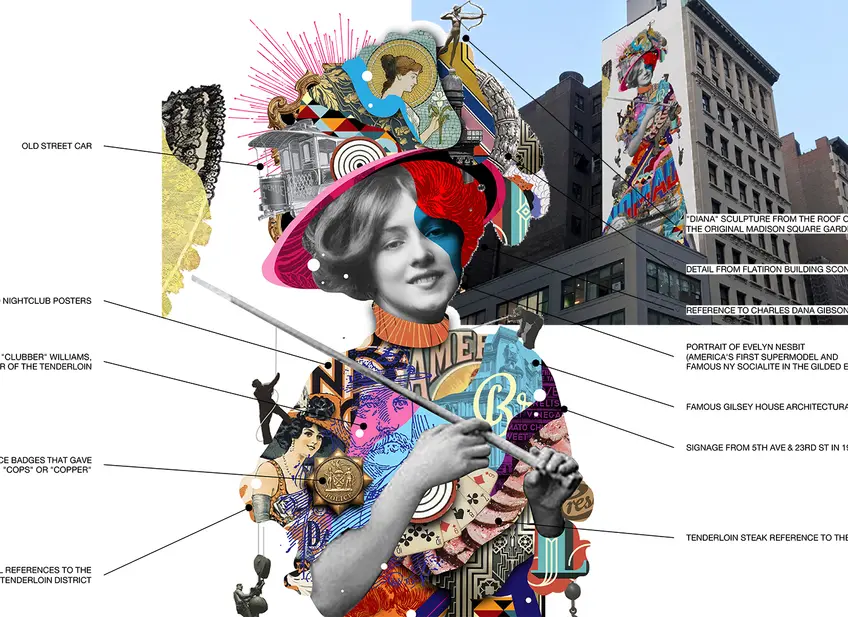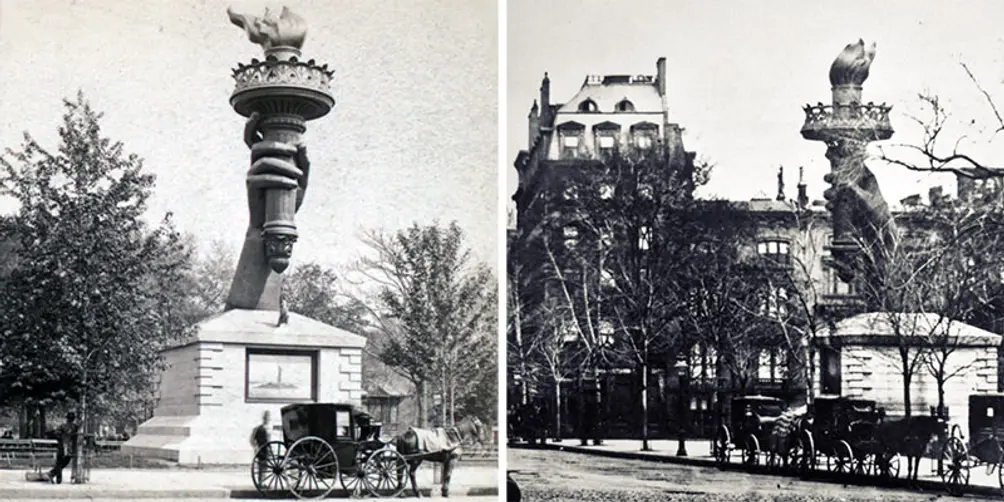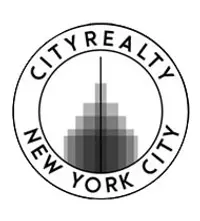 Mural proposal by Tristan Eaton via Landmarks Preservation Commission
Mural proposal by Tristan Eaton via Landmarks Preservation Commission
A proposed mural for 236 Fifth Avenue, a building along the Madison Square North Historic District and just north of the Ladies’ Mile Historic District, is going before the Landmarks Preservation Commission next week. The mural, clearly inspired by women (appropriate, given our current political climate) as well as the rich – and controversial – history of New York City, is by the popular graffiti artist Tristan Eaton, whose work can be seen from billboards to dumpsters throughout dozens of cities in the world, including Paris, Shanghai, London, Detroit, and of course, New York. His impressive list of clients includes Nike, Versace, and Barack Obama.
The outline of the mural is in the shape of a woman dressed in typical early 19th-century fashion and within it, Eaton has included a collage of historic New York elements that are part of the posh neighborhood now known as NoMad. The face is Evelyn Nesbit, a model and actress who gained worldwide notoriety in 1906 when her multi-millionaire husband, Harry Kendall Thaw, shot and killed architect and socialite Stanford White on the rooftop theatre of Madison Square Garden.
During “The Trial of the Century,” she testified that when she was 14 years old, White, then 47-years-old, sexually assaulted her while she was unconscious. After the event, her husband was branded a “protector of women,” whereas she was attacked by the media, who called her “the lethal beauty.” In the era of #metoo, we can’t help but think the choice of having Nesbit’s face lead the mural isn’t just merely a coincidence.
Another significant piece of the mural is Audrey Munson as the Miss Manhattan Sculpture. Munson, who is often regarded as America’s first supermodel, was at the height of her career in the early 1900s but was left jobless soon after and spent the last 65 years of her life in an insane asylum following her suicide attempt.
Other elements of the mural include old nightclub posters and streetcars, an eagle sculpture from Madison Square Garden, signage from 5th Avenue and 23rd Street, Art Deco designs, workers from the Empire State building, "NoMad," and Charles Dana Gibson's “Gibson Girls” art, which represented the new, independent, and educated woman that emerged in the 1890s to early 1900s.
It also references The Tenderloin District, a red-light district that was north of 23rd Street between Gramercy Park and the Hudson River. It was coined “The Tenderloin” in the post-civil war society by NYPD inspector Alexander “Clubber” Williams, who, upon being transferred to modern-day NoMad, said “I’ve had nothing but chuck steak for a long time, and now I’m going to get a little bit of tenderloin.” He was known for his corruption and brutal tactics – most of which involved him beating up suspects with his club.
It also references The Tenderloin District, a red-light district that was north of 23rd Street between Gramercy Park and the Hudson River. It was coined “The Tenderloin” in the post-civil war society by NYPD inspector Alexander “Clubber” Williams, who, upon being transferred to modern-day NoMad, said “I’ve had nothing but chuck steak for a long time, and now I’m going to get a little bit of tenderloin.” He was known for his corruption and brutal tactics – most of which involved him beating up suspects with his club.
The mural, if approved, will be very close to the Ladies’ Mile Historic District, also known as the Flatiron District, Photo District, or Midtown South, which was designated by the LPC in 1989 and includes over 400 buildings roughly between West 24th Street to West 15th Street from Sixth Avenue to Park Avenue South. The district served as a commercial retail center in the mid- to late 1800s and into the early 20th century. It was named “Ladies’ Mile” because its vast amount of grand department stores was a popular destination among women at the time, and more importantly, it signified the only place where women (specifically, white women) were allowed to go unaccompanied by men.
The article “Department Stores Are Basically the Reason Women Were Allowed in Public” published on Racked earlier this year details how the “emancipation of women started at the makeup countertop” since it was illegal for women to enter many spaces unchaperoned (those that did were thrown out). Those from a lower-class – female laborers or prostitutes – were the only women seen walking around during those times so if a middle-class housewife were out in public alone, they would be seen as a “streetwalker.”
The article “Department Stores Are Basically the Reason Women Were Allowed in Public” published on Racked earlier this year details how the “emancipation of women started at the makeup countertop” since it was illegal for women to enter many spaces unchaperoned (those that did were thrown out). Those from a lower-class – female laborers or prostitutes – were the only women seen walking around during those times so if a middle-class housewife were out in public alone, they would be seen as a “streetwalker.”
 via VinePair
via VinePair
The proposed location of the mural is also near Madison Square Park where the Statue of Liberty, another monumental woman represented through art, got her start and broadcasted her message to New Yorkers regarding accepting immigrants. Like a 19th century Kickstarter campaign, her hand and torch stood there for six years until enough money was raised to assemble the rest of the statue and its base. Finally, on October 28, 1886, the full Statue of Liberty was installed in Liberty Island.
The LPC meeting (PDF) will take place on Tuesday, October 9th at 10:30 am.
Enjoyed this Article? Like CityRealty on Facebook and follow @CityRealty on Instagram. You can also tweet us at @CityRealtyNY.

Content Specialist
Sandra Herrera
Sandra Herrera is a writer, editor, and graphic designer based in Brooklyn, NY.

 6sqft delivers the latest on real estate, architecture, and design, straight from New York City.
6sqft delivers the latest on real estate, architecture, and design, straight from New York City.
